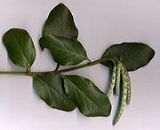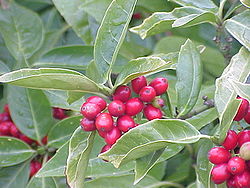
Garryaceae
Encyclopedia
Garryaceae is a small family
of dicotyledon
s, including only two genera:
 The family is found in warm temperate and subtropical regions, Garrya in North America
The family is found in warm temperate and subtropical regions, Garrya in North America
, and Aucuba in eastern Asia
. They are evergreen
shrub
s or small tree
s with opposite, simple leaves
.
Aucuba is included in the family Cornaceae
in some classification systems.
Family (biology)
In biological classification, family is* a taxonomic rank. Other well-known ranks are life, domain, kingdom, phylum, class, order, genus, and species, with family fitting between order and genus. As for the other well-known ranks, there is the option of an immediately lower rank, indicated by the...
of dicotyledon
Dicotyledon
The dicotyledons, also known as dicots, are a group of flowering plants whose seed typically has two embryonic leaves or cotyledons. There are around 199,350 species within this group...
s, including only two genera:
- GarryaGarryaGarrya is a genus of about 18 species of flowering plants in the family Garryaceae, native to North and Central America and the Caribbean. Common names include silktassel, and tassel bush....
DouglasDavid DouglasDavid Douglas was a Scottish botanist. He worked as a gardener, and explored the Scottish Highlands, North America, and Hawaii, where he died.-Early life:...
ex Lindl.John LindleyJohn Lindley FRS was an English botanist, gardener and orchidologist.-Early years:Born in Catton, near Norwich, England, John Lindley was one of four children of George and Mary Lindley. George Lindley was a nurseryman and pomologist and ran a commercial nursery garden...
, 1834. About 16-18 species. - AucubaAucubaAucuba is a genus of three to ten species of flowering plants, now placed in the family Garryaceae, although formerly classified in the Aucubaceae or Cornaceae....
Thunb.Carl Peter ThunbergCarl Peter Thunberg aka Carl Pehr Thunberg aka Carl Per Thunberg was a Swedish naturalist and an apostle of Carl Linnaeus. He has been called "the father of South African botany" and the "Japanese Linnaeus"....
, 1783. About 3-10 species.

North America
North America is a continent wholly within the Northern Hemisphere and almost wholly within the Western Hemisphere. It is also considered a northern subcontinent of the Americas...
, and Aucuba in eastern Asia
Asia
Asia is the world's largest and most populous continent, located primarily in the eastern and northern hemispheres. It covers 8.7% of the Earth's total surface area and with approximately 3.879 billion people, it hosts 60% of the world's current human population...
. They are evergreen
Evergreen
In botany, an evergreen plant is a plant that has leaves in all seasons. This contrasts with deciduous plants, which completely lose their foliage during the winter or dry season.There are many different kinds of evergreen plants, both trees and shrubs...
shrub
Shrub
A shrub or bush is distinguished from a tree by its multiple stems and shorter height, usually under 5–6 m tall. A large number of plants may become either shrubs or trees, depending on the growing conditions they experience...
s or small tree
Tree
A tree is a perennial woody plant. It is most often defined as a woody plant that has many secondary branches supported clear of the ground on a single main stem or trunk with clear apical dominance. A minimum height specification at maturity is cited by some authors, varying from 3 m to...
s with opposite, simple leaves
Leaf
A leaf is an organ of a vascular plant, as defined in botanical terms, and in particular in plant morphology. Foliage is a mass noun that refers to leaves as a feature of plants....
.
Aucuba is included in the family Cornaceae
Cornaceae
Cornaceae is a cosmopolitan family of flowering plants in the order Cornales. It contains approximately 110 species, mostly trees and shrubs, which may be deciduous or evergreen. Members of this family usually have opposite or alternate simple leaves, four- or five-parted flowers clustered in...
in some classification systems.

